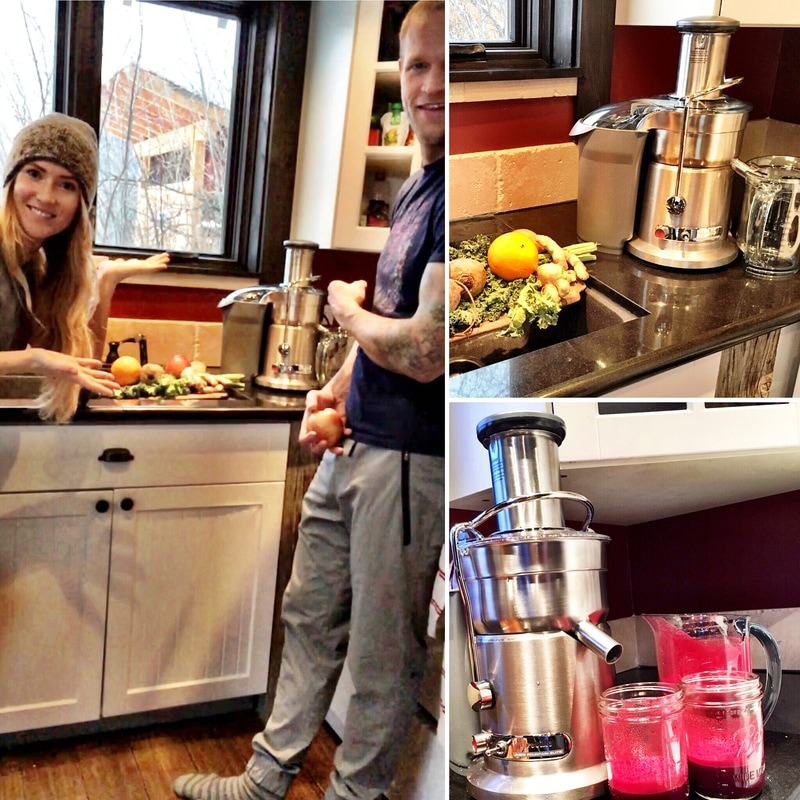|
Partway through my pregnancy, I found myself completely sick of salad.
I felt like eating enough nutrients to grow a healthy baby had become as time consuming as a full time job, and with the delicate dance around nausea, I just couldn't chew any more kale or spinach up -- no matter how much fruit or yummy, sugary dressings I tried to disguise it with. That night, my incredibly considerate and thoughtful hubby came home with a Nutribullet! I credit that blender for our baby's good health. I was able to get so many more vegetables into me by mixing them with a bit of fruit juice and frozen berries, and I could add chia seeds, pumpkin seeds, sunflower seeds and all sorts of other goodness to it if so inclined. Once I had this baby -- his name is Oakes -- I realized that I needed to keep this healthy diet going to make super-healthy breastmilk, and I wonder now: why would I stop eating so well once it's just me who benefits? Being a Gastown resident (when we aren't in Whistler) I've also always loved my regular Juice Truck fix, but I've always wondered what's actually healthier: juicing or blending? To me, It seemed counterintuitive to remove all of the fibrous portions of the vegetables and fruit, when I've always thought it to be important that I'm getting enough fibre. So I did some research. As it turns out, there are two types of fibre, and juicing only removes the insoluble fibre. The soluble fibre goes straight into my mason jar. Depending on what your goals are, there are advantages to both juicing and blending. Although our bodies don't break it down or digest it, insoluble fibre is important for our digestive systems. It acts like a sponge, absorbing fluids to keep things moving along regularly, and it also picks bits of bad cholesterol up to carry them right back out. Insoluble fibre makes it harder for nutrients to be absorbed and utilized, which puts a check in the juicing column, as long as your juice is mostly from vegetables. If you like to throw a whole bunch of fruit into your concoction, you will be better off to keep that insoluble fibre around, so it can prevent some of that sugar from being absorbed -- or at least slow the release of it down to keep blood-sugar levels from spiking. The general rule of thumb for juicing is 80% vegetables, 20% fruit -- a rule I try to live by when it comes to feeding my baby. Most people think fruit is a healthy snack, but as my public-health-nurse-mother has always said, you really need to focus on getting the veggies in first. Health Canada actually changed the name of one of the four food groups on Canada's Food Guide from 'Fruit & Vegetables' to 'Vegetables & Fruit' years ago to emphasize the importance of making nutrient-rich vegetables your priority. Fruit is great, it's just high in sugar. I often hear of people going on a juicing diet to try to lose weight. Have you ever noticed that drinking a juice doesn't really make you feel full for very long? I feel fuller for longer if I drink a smoothie. That's the thing about fibre -- it makes you feel full for longer, and then you are less likely to snack on less-than-optimal things. The truth is, I just really enjoy drinking fresh vegetable juice with a hint of fruitiness, so we now have a fancy new Breville Centrifugal Juicer to cover all of the bases! We literally had to read 'Juicing for Dummies' once we got this beautiful piece of machinery. It told us to remove skins and peels that we wouldn't normally eat, like citrus fruit peels as well as the gnarly stuff at the root of the beets. It was a family affair in our little cabin north of Whistler, as we experimented with our new mode of nutrient delivery. We tried beets, carrots, ginger, a whole lot of kale, apples, and we squeezed lemon juice on top. The end result? A delicious creation delivering: Iron, Magnesium, Calcium, Phosphorus, Thiamin, Niacin, Vitamin B6, Protein, Riboflavin, Copper, and a very good amount of Vitamin A, Vitamin C, Vitamin K, Folate, Potassium and Manganese. Say that 5 times, fast. ;) As newbies, we'd love some juicing tips, either in the comments below or on social media!
0 Comments
|
Categories
All
|


